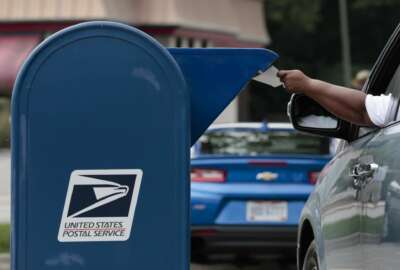The Postal Service has outlined the steps it’s taking to improve on-time mail delivery, and bring its level of service back up to standards that were in place before Postmaster General Louis DeJoy implemented some operational changes at the agency.
USPS and its legal team submitted these documents to a federal court in New York after a judge last month ordered the agency to provide a list of steps necessary to improve on-time delivery scores for first-class mail and marketing mail.
USPS data provided to the court shows national on-time delivery of first-class mail dropped in mid-July, around the same time that operational changes went into effect at the agency.
Those changes led to a significant decline in late and extra truck trips between mail-processing facilities and post offices, but also led to some delays in mail delivery, prompting multiple congressional hearings, lawsuits and a review by the USPS inspector general.
The agency reported its best week for on-time delivery in mid-February, when it delivered more than 93% of first-class mail on time. USPS reported its lowest rate of on-time delivery was the week of Aug. 8, when it delivered about 81% of first-class mail on time.
Source: Postal Service
On-time delivery improved in late August and early September, but the data shows another decline in service delivery for the week of Sept. 19.
The Postal Service, in an unsigned memo submitted by its attorneys last week, cautions that the agency “historically sees both downturns, and upticks” in mail service for reasons that are out of the agency’s control. The coronavirus pandemic, for example, continues to negatively impact service performance by limiting employee availability.
Transporting mail by plane, the agency said, has also become more complicated during the pandemic because of airline flight changes and cancellations. Hurricanes and storms along the East and Gulf coasts, as well as wildfires on the West Coast, have also complicated deliveries.
“Of course, the Postal Service works toward upward trends, over longer periods of time. Nonetheless, these scores historically show fluidity, which should be borne in mind when assessing the return to a specific historic score,” the agency wrote.
USPS has been the subject of nearly a dozen federal lawsuits following its operational changes. In five of those cases, rulings or preliminary injunctions have blocked the agency from moving ahead with plans with cutting late and extra trips.
The agency has other changes on hold, including the removal of mail sorting equipment and changing hours at post offices, until after the November election. DeJoy said in August that the agency was suspending these changes to “avoid even the appearance of any impact on election mail.”
To return on-time mail delivery rates back to what the agency saw earlier this year, USPS has instructed mail-processing facilities to finish processing mail no later than an hour before trucks are scheduled to leave. The agency said this gives employees extra time to “address unexpected issues during processing.”
USPS is also sending daily, automated “processing to plan” reports to regional vice presidents, division directors and processing plant managers. The agency said these reports flag issues in processing that local management can address they can escalate.
These automated reports can flag declines in the volume of mail processed, breaks that volume down by mail type, and compares into the expected volume of mail to be processed. These reports run every six hours for letters and flats, and can pinpoint performance issues down to specific mail-sorting machines.
USPS has also adjusted the operating windows for mail-sorting machines to maximize volume. DeJoy recently said sorting equipment targeted for removal was operating at less than half of its maximum capacity and was inefficient to keep in use. USPS will also increase staffing at facilities expected to receive the largest mail volumes.
In a draft memo to USPS supervisors and managers, the agency makes clear that late and extra truck trips are not banned, and that employees don’t need pre-approval for those trips.
“Because the proper handling and timely delivery of Election Mail is our number one priority, authorizing late and extra trips through November 6, 2020, will not result in disciplinary action,” USPS wrote. “To the contrary, late and extra trips that would facilitate the on-time delivery of Election Mail are authorized and encouraged — we are committed to using such trips to deliver Election Mail on time.”
For example, if a truck needed to be held to receive Election Mail and that delay would not cause the truck to miss a later connection that might delay other Election Mail, the truck should be held until it can receive the Election Mail.
USPS has also authorized its local operations to approve overtime if necessary to facilitate the delivery of election mail from Oct. 26 through Nov. 6.
Copyright
© 2024 Federal News Network. All rights reserved. This website is not intended for users located within the European Economic Area.

